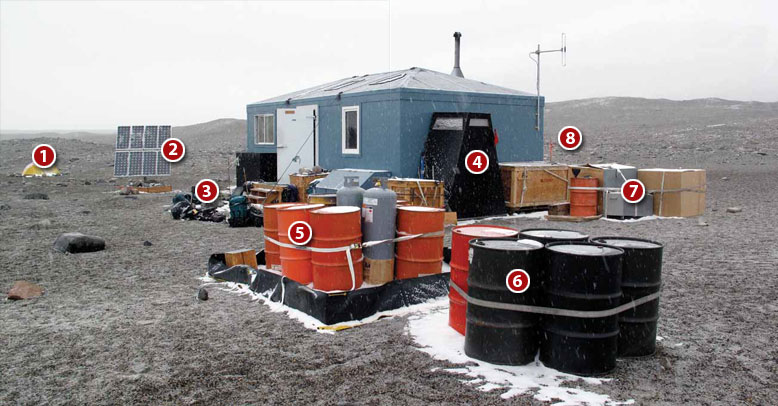
![]() Full toilet/gray water drums and propane tanks. They can only be 90 percent filled to account for expansion as the liquid freezes. Note the barrier to protect against spills.
Full toilet/gray water drums and propane tanks. They can only be 90 percent filled to account for expansion as the liquid freezes. Note the barrier to protect against spills.
![]() Spare wastewater drums, strapped together because of the wind.
Spare wastewater drums, strapped together because of the wind.
![]() Boxes contain solid garbage from our day-to-day lives.
Boxes contain solid garbage from our day-to-day lives.
![]() Not seen behind the hut: Large crate containing the survival cache with sleeping bags (2), rubber insulation mats (2), stove, dehydrated food, fuel, radio, shovel, and snow saw.
Not seen behind the hut: Large crate containing the survival cache with sleeping bags (2), rubber insulation mats (2), stove, dehydrated food, fuel, radio, shovel, and snow saw.
![]() Mountain tent. We have worked inside the hut and lived in the tents for months!
Mountain tent. We have worked inside the hut and lived in the tents for months!
![]() Solar panel: The rotating base allows us to move the panel to face the Sun as it makes the trip around the sky during the 24 hours of Antarctic daylight.
Solar panel: The rotating base allows us to move the panel to face the Sun as it makes the trip around the sky during the 24 hours of Antarctic daylight.
![]() Scientists’ gear: No critters and dry conditions mean that gear can be left outside. The downside: 24 hours of daylight will really fade your pack.
Scientists’ gear: No critters and dry conditions mean that gear can be left outside. The downside: 24 hours of daylight will really fade your pack.
![]() Simple outhouse consists of a bucket and a Styrofoam seat. To keep this pristine environment clean, waste will be capped and shipped to Antarctica’s McMurdo station.
Simple outhouse consists of a bucket and a Styrofoam seat. To keep this pristine environment clean, waste will be capped and shipped to Antarctica’s McMurdo station.
 Ian Schwartz, Casey Middle School Teacher-in-residence at McMurdo Dry Valleys, Antarctica, as part of a CIRES outreach program.
Ian Schwartz, Casey Middle School Teacher-in-residence at McMurdo Dry Valleys, Antarctica, as part of a CIRES outreach program.



